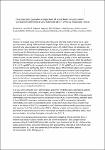One-year post-operative comparison of visual function and patient satisfaction with trifocal and extended depth of focus intraocular lenses
| dc.contributor.author | Law, EM | |
| dc.contributor.author | Aggarwal, RK | |
| dc.contributor.author | Buckhurst, Hetal | |
| dc.contributor.author | Kasaby, HE | |
| dc.contributor.author | Marsden, Jonathan | |
| dc.contributor.author | Shum, G | |
| dc.contributor.author | Buckhust, PJ | |
| dc.date.accessioned | 2022-02-17T14:19:03Z | |
| dc.date.available | 2022-02-17T14:19:03Z | |
| dc.date.issued | 2022-09 | |
| dc.identifier.issn | 1120-6721 | |
| dc.identifier.issn | 1724-6016 | |
| dc.identifier.other | ARTN 11206721211069737 | |
| dc.identifier.uri | http://hdl.handle.net/10026.1/18818 | |
| dc.description | File replaced (docx to pdf) on 26.4.23 by NK (LDS) | |
| dc.description.abstract |
Purpose To evaluate visual performance with trifocal and extended depth of focus IOL at 1 year post-operatively. Setting BMI Southend Hospital. Design Cohort study. Methods An age-matched cohort of forty subjects bilaterally implanted with the AT LISA 839MP trifocal IOL (20 patients, 40 eyes) and the Tecnis Symfony extended depth of focus IOL (20 patients, 40 eyes) were assessed at 3–6 months and 12–18 months post-operatively. Primary outcome measures were distance (6 m), intermediate (70 cm), near visual acuity (40 cm), and analysis of defocus profiles. Secondary outcomes included contrast sensitivity, Radner reading performance, quality of vision and assessment of halos. Results Distance visual acuity (VA) and defocus areas were similar (p = 0.07). No significant difference in intermediate VA was noted but the intermediate area of focus was greater in the EDoF (0.31 ± 0.12 LogMAR*m−1) compared to the trifocal (0.22 ± 0.08LogMAR*m−1) (p = 0.02). However, all near metrics were significantly better in the trifocal group. 80% of trifocal subjects were spectacle independent compared to 50% EDoF subjects. Quality of vision questionnaire found no significant differences between groups, however halo scores were greater at 3–6 months in the trifocal group (p < 0.01) but no differences were noted at 12–18 months. Conclusions Near vision is significantly better for the trifocal, thus greater levels of spectacle independence. The range of intermediate vision was greater for the EDoF but no difference in intermediate VA. In the early period, differences in contrast sensitivity and halo size/intensity were noted, however, by one-year these measures were not significantly different. | |
| dc.format.extent | 2967-2974 | |
| dc.format.medium | Print-Electronic | |
| dc.language | en | |
| dc.language.iso | eng | |
| dc.publisher | SAGE Publications | |
| dc.rights | Attribution 4.0 International | |
| dc.rights.uri | http://creativecommons.org/licenses/by/4.0/ | |
| dc.subject | Child, Preschool | |
| dc.subject | Cohort Studies | |
| dc.subject | Humans | |
| dc.subject | Lens Implantation, Intraocular | |
| dc.subject | Lenses, Intraocular | |
| dc.subject | Patient Satisfaction | |
| dc.subject | Prospective Studies | |
| dc.subject | Prosthesis Design | |
| dc.subject | Pseudophakia | |
| dc.subject | Refraction, Ocular | |
| dc.subject | Vision, Binocular | |
| dc.title | One-year post-operative comparison of visual function and patient satisfaction with trifocal and extended depth of focus intraocular lenses | |
| dc.type | journal-article | |
| dc.type | Journal Article | |
| plymouth.author-url | https://www.webofscience.com/api/gateway?GWVersion=2&SrcApp=PARTNER_APP&SrcAuth=LinksAMR&KeyUT=WOS:000736592000001&DestLinkType=FullRecord&DestApp=ALL_WOS&UsrCustomerID=11bb513d99f797142bcfeffcc58ea008 | |
| plymouth.issue | 5 | |
| plymouth.volume | 32 | |
| plymouth.publication-status | Published | |
| plymouth.journal | European Journal of Ophthalmology | |
| dc.identifier.doi | 10.1177/11206721211069737 | |
| plymouth.organisational-group | /Plymouth | |
| plymouth.organisational-group | /Plymouth/Admin Group - REF | |
| plymouth.organisational-group | /Plymouth/Admin Group - REF/REF Admin Group - FoH | |
| plymouth.organisational-group | /Plymouth/Faculty of Health | |
| plymouth.organisational-group | /Plymouth/Faculty of Health/School of Health Professions | |
| plymouth.organisational-group | /Plymouth/REF 2021 Researchers by UoA | |
| plymouth.organisational-group | /Plymouth/REF 2021 Researchers by UoA/UoA03 Allied Health Professions, Dentistry, Nursing and Pharmacy | |
| plymouth.organisational-group | /Plymouth/Research Groups | |
| plymouth.organisational-group | /Plymouth/Research Groups/FoH - Applied Parkinson's Research | |
| plymouth.organisational-group | /Plymouth/Research Groups/Institute of Health and Community | |
| plymouth.organisational-group | /Plymouth/Users by role | |
| plymouth.organisational-group | /Plymouth/Users by role/Academics | |
| dc.publisher.place | United States | |
| dcterms.dateAccepted | 2021-12-06 | |
| dc.identifier.eissn | 1724-6016 | |
| dc.rights.embargoperiod | Not known | |
| rioxxterms.versionofrecord | 10.1177/11206721211069737 | |
| rioxxterms.licenseref.uri | http://creativecommons.org/licenses/by/4.0/ | |
| rioxxterms.type | Journal Article/Review |



